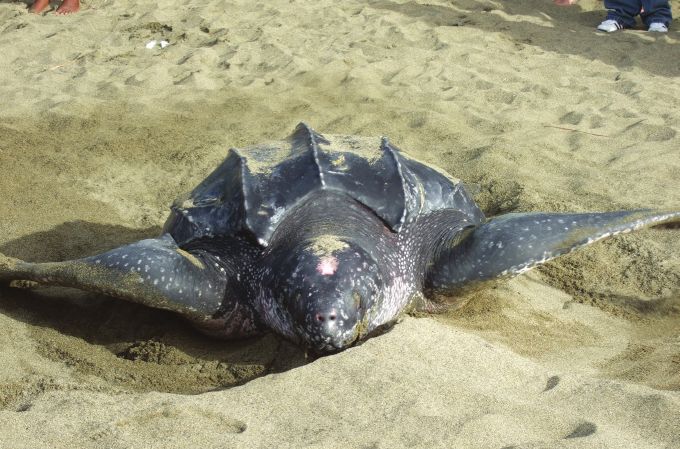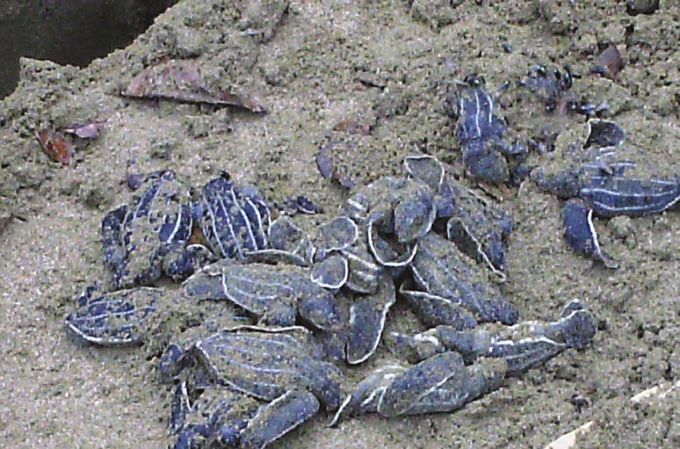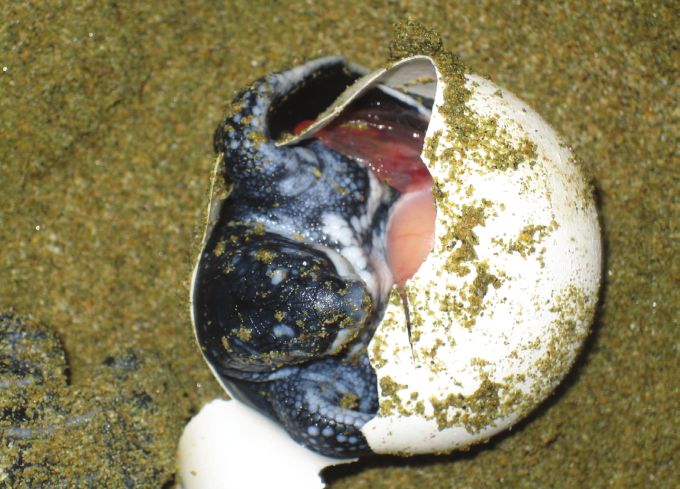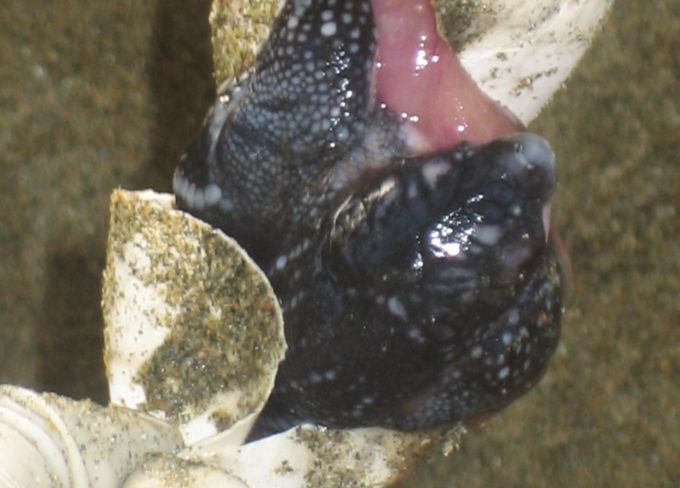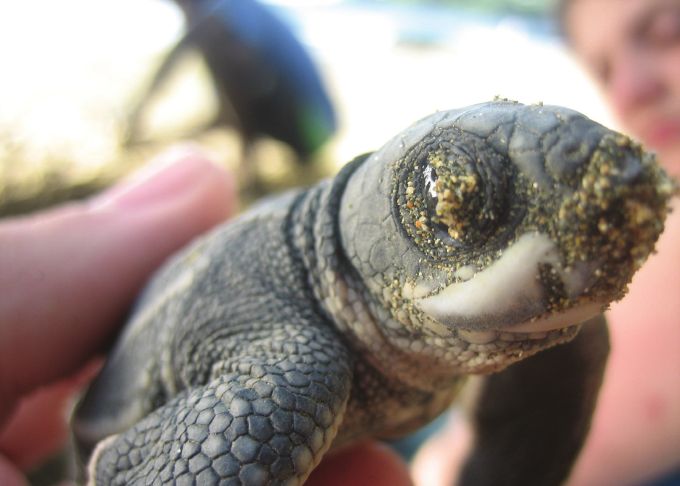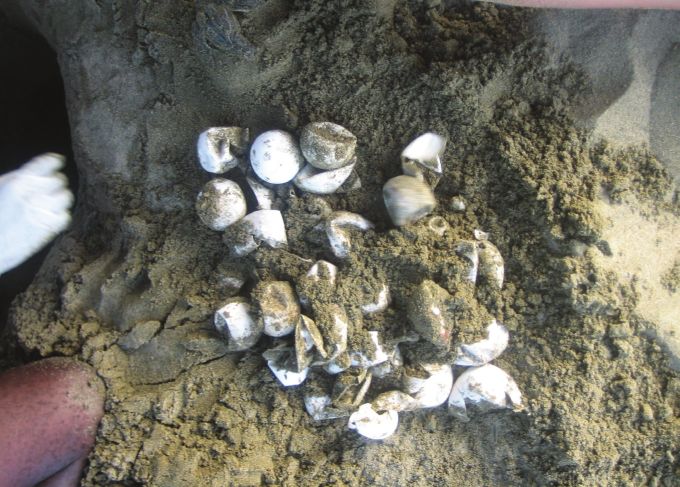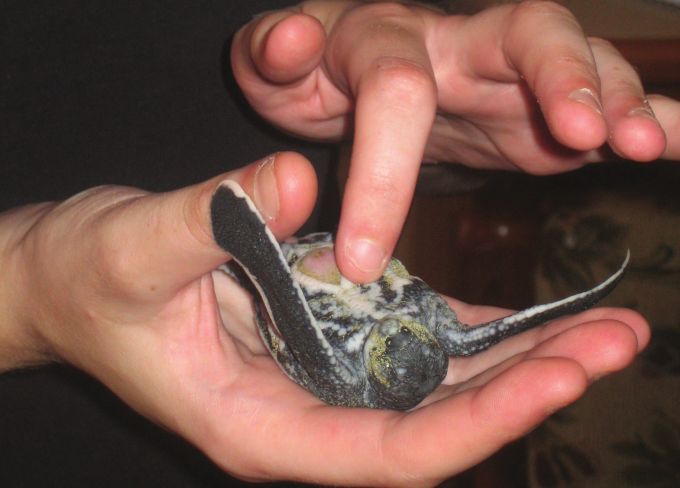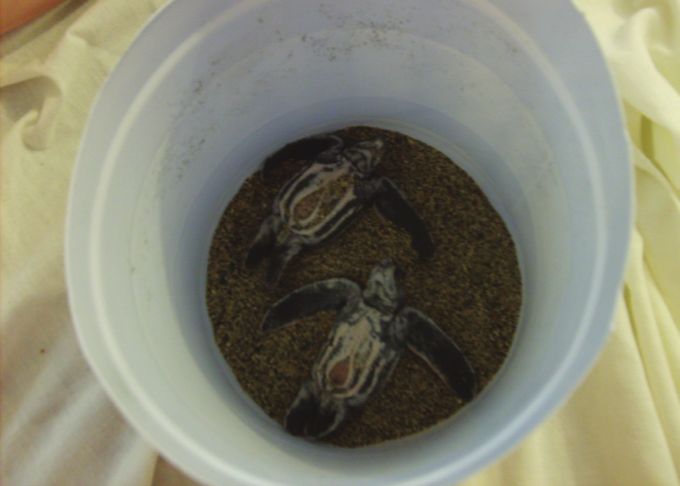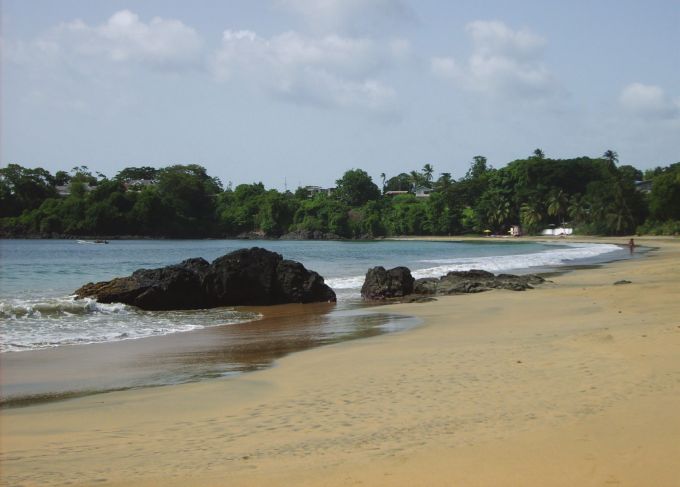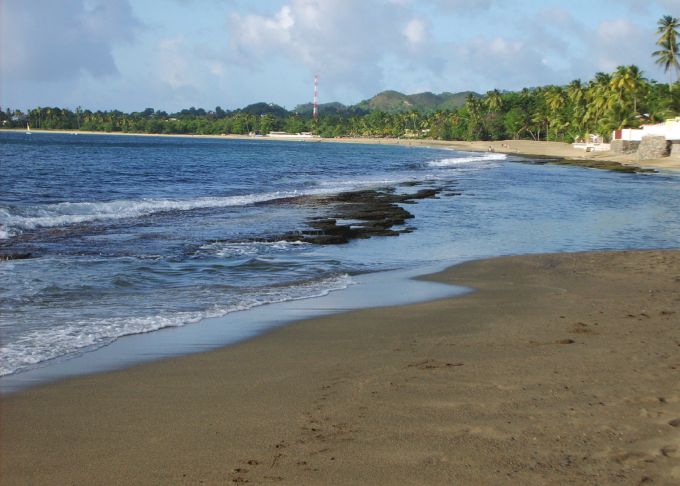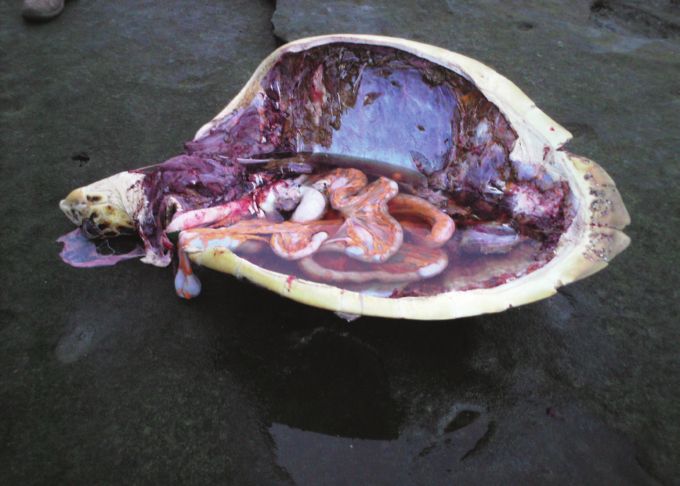Kirsty Reid, Expedition Leader
Located at latitude 11° 9’ N, longitude 60° 40’ W, and only 300km² in size, the small Caribbean island of Tobago is frequented by numerous marine turtle species. The leatherback turtle (Dermochelys coriacea), the hawksbill turtle (Eretmochelys imbricata), and the green turtle (Chelonia mydas) all nest on the beaches of Tobago and, in the light of their worrying conservation status, the leatherback and hawksbill turtles are currently listed as critically endangered on the IUCN Red List of Threatened Species, whilst the green turtle is listed as endangered. Combined with the knowledge that all three species are believed to return to their natal coastline to lay, it is clearly of great importance that the nesting beaches on Tobago are actively protected.
SOS Tobago
For over 10 years, the monitoring and protection of Tobago's beaches and their nesting turtles have been conducted by a small group of local people, who began their work almost 10 years ago in response to the number of turtle carcasses found strewn along the shore. The NGO SOS Tobago was officially born in 2000, with the mission statement ‘To conserve sea turtles and their coastal and marine habitats in Tobago through community initiatives in education, research and ecotourism. In 2005, they initiated a flipper tagging programme with direct support from Nature Seekers in Trinidad and the Wider Caribbean Sea Turtle Network (WIDECAST). Despite operating with their government’s blessing and being obliged to pass all data collected on nesting females and hatchlings to them, to date SOS Tobago has received no financial support from the government. However, they have been recognised both locally and internationally for their exemplary conservation effort, and in 2000 were awarded the BP Amoco Leader Award in Environmental Conservation.
The role of University of Glasgow undergraduates
The University of Glasgow has a standing working relationship with SOS Tobago. The primary University of Glasgow expedition to Tobago was conducted in 2004, the aim of which was to determine the viability of conducting annual research and implementation of conservation measures on nesting sea turtle populations. In addition to elucidating the potential for the aforementioned objectives, the expedition highlighted the need of SOS Tobago for biologically-trained manpower. Further expeditions to assist SOS Tobago in their work have been conducted annually since. The expedition of 2007 worked in Tobago from 10th June to 16th August, at the peak of the nesting season.
The primary role of expedition members whilst in Tobago was to assist SOS Tobago in their nightly beach patrols. The expedition was based in the village of Black Rock, where SOS Tobago originated. There are three index beaches in this area: Turtle Beach, Grafton Beach and Back Bay. Patrols were approximately five hours in length, variable in accordance with sunrise and high tide, and consisted of continuous walks of the beach to check for turtle activity. If a female turtle was spotted one or several members of the patrol, dependent on the number of females simultaneously nesting on the beach, would stay with her until her safe return to the sea. The time of emergence from the sea, weather conditions, area of the beach and a landmark for nest identification (nests were unmarked due to poaching) were recorded for each turtle. Only when a female had finished digging her body pit and begun the process of laying was it appropriate to approach her; once laying has begun females are committed to the process and enter a ‘trance’, rendering them immobile, making it safe for patrollers and relatively stress-free for the animals to be approached. Upon reaching a turtle, patrollers checked for recent injuries and recorded any distinguishing features, for example missing parts of the shell. The length and width of the carapace were measured, and flipper tag numbers recorded. If untagged, leatherbacks were tagged on both rear flippers and hawksbills on both front flippers, where tags and equipment were available. Time of return to the sea was recorded, in addition to any potential causes of disturbance or unusual activity displayed by the turtle during the laying process. All data were recorded, and an extract from the resulting spreadsheets is shown in Table 1.
| Date | Dy | Species | Beach | Zone | Landmark | Time seen | Activity | Time out | Outcome | Ccl | Ccw | Tag1 | Tag2 | Last seen? | Marks/injuries | Other comments |
|---|
| 10/06/07 | Sn | Lb | Tb | 1 | | 10.05 Pm | Digging | 12.02 Am | Cl | 148 | 120 | | | | | Scots training |
| 10/06/07 | Sn | Lb | Tb | 1 | | 10.23 Pm | Covering | 12.13 Am | Cl | | | T33077 | T33788 | 01/06/07 | | Scots training |
| 10/06/07 | Sn | Lb | Tb | 1 | | 23:45:00 | Covering | 12.00 Am | Cl | | | T33049 | T33047* | 20 Jun 05 tb* | | Scots training |
| 10/06/07 | Sn | Lb | Tb | 1 | | 12.37 Am | Digging | 01:40:00 | Cl | | | T33953 | T33907 | 23/05/07 | | |
| 12/06/07 | T | Lb | Tb | 3 | Black Rock River | 9.00pm | Body pit | 10.54 Pm | Cl | 140 | 124 | T33055 | T33054 | | Rear end of carapace missing, affect measurement. Rrf badly damaged, lrf ragged edges and hole. | Cc, scots |
| 12/06/07 | T | Lb | Tb | 2 | Middle Hotel | 10.10 Pm | Approaching | 12.15 Am | Cl | 160 | 142 | T33962 | T33592 | 01/06/07 | Left tag missing and replaced | Hotel lights disoriented turtle, had to be led back in |
| 13/06/07 | W | Lb | Tb | 3 | Seagrapes | 11.30 Pm | Approaching | 12.50 Am | Cl | 157 | 128 | | | | Notches rff, smaller rrf, old lacerations on carapace | Nap and glasgow training |
| 14/06/07 | Th | Lb | Bb | 3 | | 1.38 Am | Approaching | 3.10 Am | Cl | 147 | 111 | | | Wc4356 | 2 Bite marks on trailing edge of lff | Sos out of new tags, waiting on trini. |
| 14/06/07 | Th | Lb | Gb | 2 | Dive Shop | 10.40 Pm | Approaching | 12.40 Am | Cl | 159 | 121 | T33972 | T33974 | | Rope burn lff, rff and right shoulder | |
| 14/06/07 | Th | Lb | Tb | 3 | Sos Sign | 1.02 Am | Approaching | 2.55 Am | Cl | 155 | 127 | T33713 | T33919 | | | |
| 14/06/07 | Th | Lb | Tb | 2 | Watersports | 1.30 Am | Approaching | 3.32 Am | Cl | | | T33746 | T33908 | | | |
| 14/06/07 | Th | Lb | Tb | 2 | T-Squares | 1.35 Am | Approaching | 3.22 Am | Cl | | | | | | Did not get a chance to tag or measure | |
| 14/06/07 | Th | Lb | Tb | 2 | Life Buoy | 1.40 Am | Approaching | 3.20 Am | Cl | | | | T33959 | | Lrf had weird wound surrounded by white. Barnacles on carapace. | |
| 14/06/07 | Th | Lb | Bb | 1 | | 1.07 Am | Covering | 1.30 Am | El | | | T33973 | T33975 | | Hole in lff | |
| 14/06/07 | Th | Lb | Gb | 3 | Seagrapes | Dns | Dns | Dns | El | Dns | Dns | Dns | Dns | | | |
| 14/06/07 | Th | Lb | Tb | 3 | Black Rock River | 10.00 Pm | Approaching | 10.15pm | Fc | | | | | | | Turtle was scared off by lights from car in the track |
| 14/06/07 | Th | Lb | Tb | 2 | Security Booth | 1.05 Am | Approaching | 1.15 Am | Fc | | | T33056 | No tags left | 05 Jun 05 tb | | |
| 15/06/07 | F | Lb | Tb | 2 | Security Booth | 1.50 Am | Approaching | 3.40 Am | Cl | 154 | 118 | | | | | |
| 15/06/07 | F | Lb | Tb | 3 | Dry River | 2.00 Am | Body pit | 3.20 Am | Cl | 153 | 115 | T33978 | | | | |
| 15/06/07 | F | Lb | Bb | 2 | | 1.30 Am | Leaving | 1.40 Am | El | | | | | | | Scots |
| 15/06/07 | F | Lb | Tb | 2 | | 3.05 Am | Covering | 4.00 Am | El | | | | | | Rff notched on trailing edge | No tags, no measuring tape, scots solo |
| 15/06/07 | F | Lb | Bb | 2 | | 1.15 Am | Leaving | 1.20 Am | Fc | | | | | | | |
| 15/06/07 | F | Hwk | Bb | 3 | | Dns | Dns | Dns | Fc | | | | | | | |
| 15/06/07 | F | Lb | Bb | 2 | | 1.30 Am | Leaving | 1.35 Am | Fc | | | | | | | |
| 15/06/07 | F | Lb | Bb | 2 | | 2.15 Am | Approaching | 2.25 Am | Fc | | | | | | Lrf | |
| 16/06/07 | St | Lb | Bb | 1 | Middle track | Dns | Dns | Dns | El | | | | | | | |
| 17/06/07 | Sn | Lb | Tb | 3 | Seagrapes | 2.30 Am | Approaching | 4.30 Am | Cl | 153 | 123 | T33910 | T33920 | 09/06/07 | Bite mark on lff | |
| 17/06/07 | Sn | Lb | Tb | 2 | Beach bar | 3.00 Am | Body pit | 4.43 Am | Cl | 149 | 117 | T33088 | Should be 05 couldn’t find in records | | Tag hole on rrf | |
| 17/06/07 | Sn | Lb | Tb | 3 | Seagrapes | 9.15 Pm | Covering | 10.21 Pm | Cl | | | | | | Couldn’t check her up close as another turtle was just approaching. | |
| 17/06/07 | Sn | Lb | Tb | 3 | Seagrapes | 9.40 Pm | Body pit | 11.05 Pm | Cl | | | | | | | |
| 17/06/07 | Sn | Lb | Tb | 2 | Security booth | 1.40 Am | Covering | 2.10 Am | El | | | | | | | |
| 17/06/07 | Sn | Lb | Tb | 3 | Seagrapes | 10.20 Pm | Approaching | 10.30 Pm | Fc | | | | | | Scared off by dogs | |
| 17/06/07 | Sn | Lb | Tb | 3 | Seagrapes | | | | | | | | | | | |
| 18/06/07 | M | Lb | Tb | 3 | Sos sign | 9.30 Pm | Approaching | 12.30 Am | Cl | | | | T33957 | | Lrf damaged, poss. Bite, unable to dig with it and tried to nest in surf, eggs relocated. | Nest relocated to 60ft from vegetation line in line with sos sign. |
| 19/06/07 | T | Lb | Gb | 3 | | 10.35 Pm | Digging | 11.48 Pm | Cl | 152 | 128 | T33968 | | | | |
| 19/06/07 | T | Lb | Tb | 2 | Pool | 8.55 Pm | Approaching | 10.35 Pm | Cl | | | T33077 | T33788 | | | Cc, scots |
| 19/06/07 | T | Lb | Tb | 2 | Beach bar | 12.00 Am | Body pit | 1.40 Am | Cl | | | | | | | |
| 19/06/07 | T | Hwk | Tb | 3 | | 2.18 Am | Digging | 3.30 Am | Cl | 87 | 76 | | | | Fragments of posterior shell missing | |
| 20/06/07 | W | Lb | Bb | 2 | | 1.16 Am | Digging | 3.00 Am | Cl | 153 | 127 | T33936 | | | | |
| 22/06/07 | F | Lb | Tb | 2 | Middle hotel | 9.20 Pm | Approaching | 23:15:00 | Cl | | | T33055 | T33054 | | Back of shell missing | |
| 23/06/07 | St | Lb | Tb | 3 | Bl. Rk river | 11.20 Pm | Digging | 1.10 Am | Cl | | | T33963 | T33959 | | Bleeding cuts on lrf, notch on rrf | Laid very high up, quite close to river. |
| 23/06/07 | St | Lb | Bb | 2 | | 11.30 Pm | Covering | 11.45 Pm | El | 149 | 119 | | | | | |
| 24/06/07 | Sn | Lb | Bb | 2 | | 12.00 Am | Covering | 12.50 Am | Cl | 154 | 118 | | | | | |
| 24/06/07 | Sn | Lb | Gb | 3 | Old sign | 2.45 Am | Covering | 3.20 Am | Cl | 157 | 114 | | | | 2 Prop cuts perpendicular to ridge across tail end of carapace | |
| 24/06/07 | Sn | Lb | Gb | 3 | Pp track | 2.50 Am | Leaving | 2.55 Am | El | | | | | | | |
| 24/06/07 | Sn | Lb | Gb | 3 | Pp track | Dns | Dns | Dns | El | Dns | Dns | Dns | Dns | | | |
| 24/06/07 | Sn | Lb | Bb | 2 | | 1.00 Am | Approaching | 2.30 Am | Fc | | | | | | Turtle never emerged from surf - seemed to be injured, no power to come up beach but then swam off strongly just as we were about to lift her on to beach. | |
| 24/06/07 | Sn | Lb | Tb | 1 | Middle river | 10.30pm | Digging | 11.45 Pm | Fcb | | | | | | No tags or distinguishing marks | Dug too close to river, nest kept getting waterlogged, eventually abandoned after 2 attempts |
| 25/06/07 | M | Lb | Tb | 3 | Bl. Rk river | 11.55 Pm | Covering | 12.40 Am | Cl | | | | | | No tags, too late to measure | Dug too close to shore but we arrived too late to relocate the nest |
| 25/06/07 | M | Lb | Tb | 1 | Cell tower | Dns | Dns | Dns | Fc | Dns | Dns | Dns | Dns | | | |
| 26/06/07 | T | Lb | Tb | 3 | Security booth | 1.16 Am | Body pit | 2.25 Am | Cl | | | | | | No tags, very unsettled, lots of barnacles | Tourists conirmed lay while we were with another turtle |
| 26/06/07 | T | Lb | Tb | 3 | Bl. Rk river | 1.50 Am | Body pit | 4.10 Am | Cl | | | T33981 | | | Few scars, wear and tear on carapace | |
| 26/06/07 | T | Hwk | Tb | 4 | Rocky shelf | 5.00 Am | Dead | Dead | Dead | | | | | | Hwks poached in bushes, shell and innards deposited on edge of rocky shelf, taken by sea by 6 am (see pics) | |
| 26/06/07 | T | Lb | Gb | 1 | Seahorse | 10.35 Pm | Digging | 11.18 Pm | Fc | | | | | | Digging in surf, abandoned nest | |
| 28/06/07 | Th | Lb | Tb | 3 | Seagrapes | 9.30 Pm | Approaching | 11.20 Pm | Cl | | | T33077 | T33788 | | | |
| 28/06/07 | Th | Lb | Tb | 2 | Security booth | 2.15 Am | Covering | 3.00 Am | Cl | | | | | | | |
| 28/06/07 | Th | Lb | Tb | 3 | | 11.10 Pm | Digging | 11.40 Pm | Fcb | | | | Wc 5612 | | Deformed rear flipper - lrf is a stump, rrf small attempted to nest in surf and gave up | |
| 29/06/07 | F | Lb | Tb | 3 | Calabash shed | 9.18 Pm | Approaching | 10.31 Pm | Cl | | | | | | | |
| 29/06/07 | F | Lb | Tb | 3 | Bl. Rk river | 10.30 Pm | Approaching | 12.32 Am | Cl | | | | Wc5612 | | Still deformed but managed this time with help | |
Table 1. An extract from the data recorded from 10th–29th June 2007
| Lb = leatherback | Tb = Turtle Beach | El = expected lay |
| Hwk = hawksbill | Bb = Back Bay | Cl = confrmed lay |
| | Gb = Grafton Beach | Fc = false crawl |
| | | Rff = right front flipper, etc. |
Nest excavations were carried out as soon as possible (within 24 hours) once they were identified as having hatched. Identification was via hatchling tracks, and a shallow indentation in the sand. At night, hatchlings recovered were taken to a dark area of the beach and released. During the day (several expedition members encountered a nest hatching at 15.00hrs) hatchlings were taken back to the accommodation and placed in a sandy bucket indoors to regain strength before release that night. When excavating, empty shells were counted in order to establish how many had successfully hatched. Dead turtles in the nest were counted, and unhatched eggs were opened to determine whether development had been unsuccessful due to infection, (made evident by the egg containing only a pink slime) or whether the turtle had died in the shell during development.
Sea turtles and ecotourism
Predominantly on Turtle Beach, where there is a large hotel complex on the beachfront, there would often be large numbers of tourists present due to paid turtle-watching tours being conducted. A major part of patrol work was therefore crowd control, for example ensuring quiet and that no white lights were used, in addition to answering questions posed by the tourists. During the brief window of laying during which it was safe to approach the female, it was the responsibility of patrollers to ensure proper conduct was observed, and that the laying pit did not cave in whilst tourists were shown the eggs. Occasionally an over-zealous tour guide would pose problems for patrollers; often they claimed ownership of the turtle and encouraged irresponsible behaviour around the nesting female during the laying process and her return to the sea. However, most of the tour guides work alongside SOS Tobago so were a welcome presence on the beach, in terms of helping to protect the best interests of the turtles whilst encouraging the ecotourism aspect of the nesting season in an informative and respectful manner.
Poaching
The Trinidad and Tobago Conservation of Wildlife Act, Chapter 67:01, bans the hunting of all wildlife during the close season (1st March to 30th September, coinciding with the sea turtle breeding season). Tobago is a signatory of the Convention on Trade in Endangered Species of Fauna and Flora (CITES) which lists leatherback, hawksbill and green turtles in Appendix 1, meaning they are threatened with extinction and may not be traded. Tobago is also subject to section 4 of the Local Fisheries Act of 1975, the Protection of Turtle and Turtle Egg Regulations, which states that the catching, killing or selling of turtles is forbidden during the close season. It further bans hunting within reef or near- shore waters and possession and sale of eggs throughout the year. Despite these regulations, enforcement is inadequate. A particular problem is harvest time, which is celebrated individually by each village on the island, mostly occurring during the close season. Unfortunately the demand for wild turtle or ‘wildmeat’ at this time is high, as tradition dictates, and adult females are lost each season as a result. Therefore, another function of patrols was to act as a deterrent to poachers as a consequence of our presence on the beach. Knowledge of SOS Tobago's activity within the Black Rock area is widespread and appears to be an effective deterrent as poaching incidences have declined since the organisation’s establishment; unfortunately, however, during 2007 a hawksbill was lost to poaching on Turtle Beach close to the time of the harvest celebrations in Black Rock village.
It was feared that many poachers had turned their focus to the North of the island, where until recently beaches had been unpatrolled. 2007 saw the establishment of SOS Tobago patrols on northern beaches, manned by expedition members from Napier University in Edinburgh and local fishermen. Communication with the Charlotteville-based SOS group confrmed a much more immediate presence of poachers on the beaches, and a visit to the area provided significant evidence of past poaching activity. Again the presence of patrollers on the beaches is believed to be an effective deterrent, as incidences of poaching declined.
Education in the community
The education of local people about sea turtles by SOS Tobago does not begin and end with information provided on the beach during patrols. Several expedition members led a full-day session at a school summer camp, organised by Giancarlo Lalsingh of SOS Tobago and Environment Tobago. The camp was run with the aim of educating children about conservation issues. For the session several presentations were prepared about the turtle species found in Tobago, the problems facing these species and what the children could do to help. Outdoor games were devised based on the principles of the presentation – for example ‘Turtle and Predator’ and ‘Pollution Pathway’. The children were very responsive to the messages of the presentation, and showed a genuine enthusiasm for conservation.
Season conclusions: problems faced by turtles and with data collection
Only a small number of tagging applicators are owned by SOS Tobago. On account of the establishment of the SOS group in the North of the island, the Black Rock group only had access to two leatherback tagging applicators, and occasional access to a hawksbill applicator; hawksbills are more prevalent in the North of the island so the applicator was mostly kept with the Napier group who were based there. As a result of this, there were some nesting turtles that returned to the sea unavoidably untagged. It is hoped that data collected regarding injuries and distinguishing features may be useful in identifying untagged turtles should they return.
As on previous expeditions, some nesting turtles could also not be tagged as the appropriate moment did not present itself. Females that were not encountered during the appropriate laying stage, for example false crawls (when a female dug a body pit but did not lay) or post-laying discoveries of nests, could not be tagged. This was unavoidable and it is likely that such females will be tagged if they return.
Nesting leatherbacks encountered similar problems to those in previous years. Turtle Beach had several sources of ‘light pollution’. The fishermen’s building had bright exterior lights; however, on the occasion that a female nested near to the building, the fishermen were most co-operative and turned the lights off in addition to moving some boats clear of the turtles path. The megawatt floodlights of the sports courts at one end of Turtle Beach were worryingly bright. However, whilst they are certainly a source of light pollution and it would be beneficial to Turtle Beach to have them switched off at night, no one nesting turtle can be singled out from this year and said to have definitely suffered disorientation as a result of these lights. No nests were observed hatching on Turtle Beach during the expedition; however, it is known that hatchlings are more sensitive to light than adult females so it is possible that these lights could pose problems for them.
The motion-sensor security lights in front of the Turtle Beach Hotel were the main concern with regard to light pollution. As the stretch of beach in front of the hotel is the area of the beach most favourably landscaped for approaching leatherbacks, a significant proportion of the females nesting on Turtle Beach did so in front of the hotel. It is highly likely that the bursts of bright light (occasionally very frequent depending upon where the turtle was positioned during the laying process) served to disorientate the turtles and cause them to take longer over the nesting process, and to become disoriented upon their return to the sea. There is severe physiological strain placed upon turtles when on land and it is therefore beneficial to the turtles to complete the laying process in as short a time as possible; light pollution is hypothesised to be a hindrance to this. SOS has tried on numerous occasions to negotiate light use with the hotel but with limited success. Fortunately, the susceptibility of turtles to bright light meant any disorientated turtles were easily led back to sea by SOS patrollers using a white torch aimed at the sand approximately one metre in front of the turtle.
Whilst reasonably high numbers of nesting females were recorded, few nests were actually observed to have hatched during our expedition. Although it is likely that many were simply not due to hatch until after the expedition had left, even so fewer than expected hatched whilst we were there. It is difficult to pinpoint what the cause of this is, as there is a whole multitude of potential reasons: possible infection of eggs, false lays, predation, or more intricate environmental factors. It is also possible that nests hatched and escaped notice, but unlikely as SOS would have used data collected on nesting females to estimate when particular nests would be hatching. Due to a particularly bad storm, during which Tobago was on severe weather warning, the area of Back Bay at which the majority of the turtles were nesting was washed out. It is almost certain that all the nests laid there were lost.
Expedition conclusions
All members of the expedition were undergraduate students of the biological sciences, for the most part zoologists. The opportunity to work in the field with such magnificent creatures as the sea turtles, and such committed and passionate conservationists as the members of SOS Tobago, allowed those on the expedition to relate all that we had learned in the lecture theatre to the reality of conservation today, and to gain an invaluable insight into the problems faced both by the species and those working to save them from extinction. As the only organisation in Tobago, NGO or otherwise, that is committed solely to the protection of sea turtles, SOS Tobago will, it is hoped, continue to grow in stature, attracting more community involvement and support from both local government and overseas institutions. The organisation will then be able to extend their protection of sea turtle species across the island, in line with the initiation of a Charlotteville group.
Acknowledgements
I gratefully extend thanks to the British Chelonia Group (BCG) and other funding sources for enabling the expedition to proceed. Thanks are also extended to all members of SOS Tobago: Tanya Clovis, Gervais Alkins, Jimmy-Jason Ayres and Giancarlo Lalsingh, for their inspiring enthusiasm, professionalism and dedication to their work. Thanks to the THA for facilitating the research opportunity, and also to the members of the expedition for all their hard work.
For more information on the work done by SOS Tobago: www.sos-tobago.org
Testudo Volume Six Number Five 2008
Top

